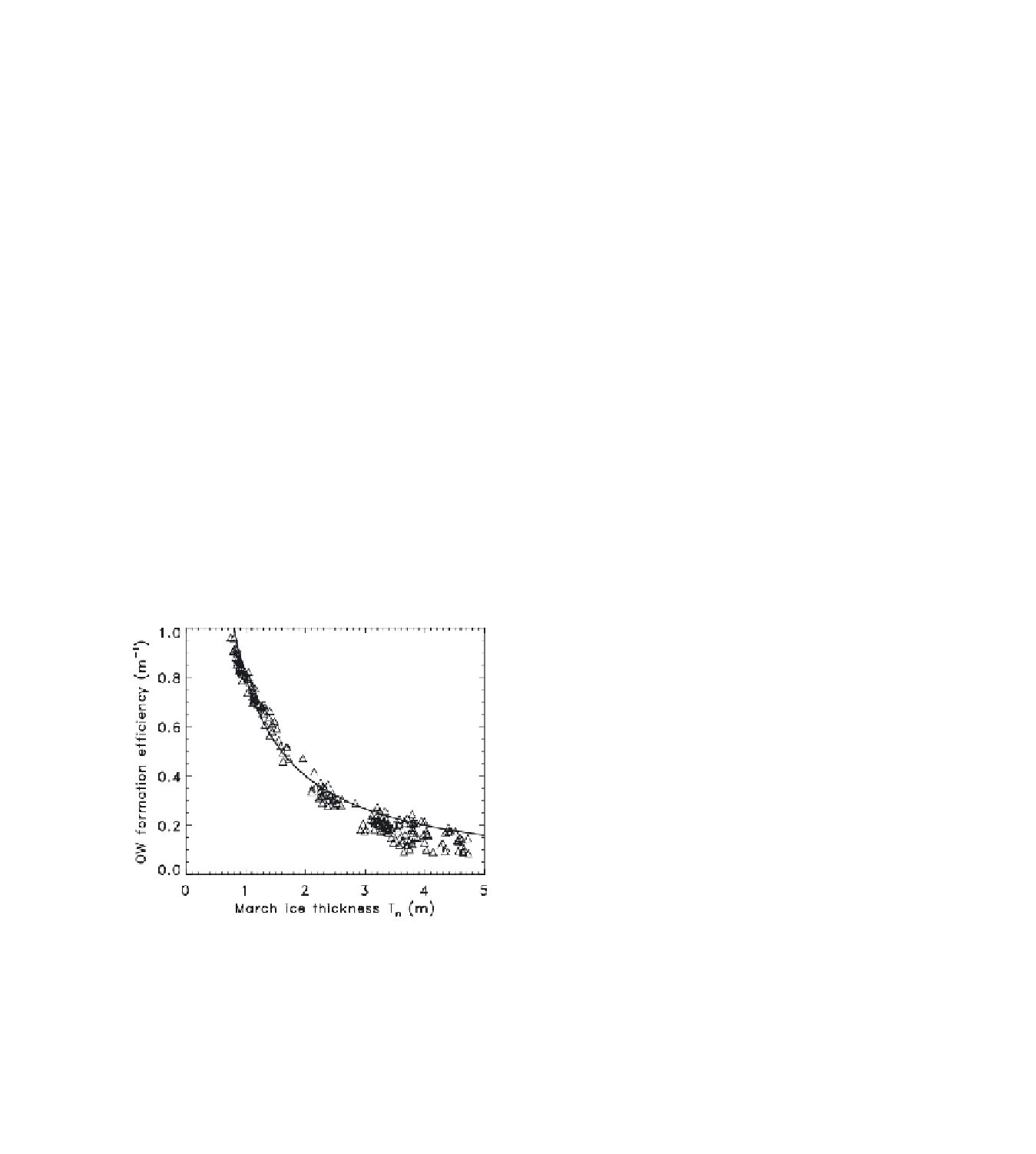Geoscience Reference
In-Depth Information
3.2.1. Efficiency of open water formation.
HBT define the
efficiency of open water formation as the open water formed,
as a fraction of
A
max
, per meter of areal mean ice melt ac-
cumulated over the May-August melt season. In Figure 3,
annual values of open water formation efficiency are plotted
against mean March ice thickness (representing the winter-
time maximum) for the simulation shown in Figure 1.
The rapid increase in open water formation efficiency with
decreasing March ice thickness was identified by HBT as
playing an important role in the simulated abrupt transitions.
This behavior is parameterized here by
T
*
= 0.8
(solid curve in Figure 3), a value used subsequently
except where noted.
3.2.2. Ocean heat transport.
The second factor identified
by HbT as contributing to abrupt transitions are rapid tran-
sient increases in ocean heat transport (OHT). These “puls-
es” resemble observed sudden warmings in Atlantic waters
entering the Arctic Ocean [e.g.,
Polyakov et al.
, 2005] and
are superimposed on a more gradual increase in OHT quali-
tatively similar to that seen in other climate models [
Holland
and Bitz
, 2003]. The transient OHT increases tend to lead
the sea ice abrupt transitions by 1-2 years (HbT). In Figure
4a, the solid curve represents OHT for the CCSM3 realiza-
tion depicted in Figure 1. This time series features a sudden
increase near 2025 which appears to be associated with the
sea ice abrupt transition.
The more gradual increase in OHT associated with climatic
warming was examined by
Bitz et al.
[2006] in a CCSM3 run
subject to 1% year
-1
increase in CO
2
. They showed the OHT
increase to be attributable both to warmer water entering
from the subpolar Atlantic and increased volume transport
into the Arctic basin (primarily the latter). This increased
ventilation peaks at around the time of CO
2
doubling, and
bitz et al. argued that it is driven by an increase in buoyancy
forcing caused by increased sea ice production that results
from more open water, thinner summer ice, and the inverse
dependence of winter sea ice growth on ice thickness. (This
effect could be represented schematically in Figure 8 as an
arrow directed from “increased open water” to “increased
OHT.”)
The evolution of OHT is represented here according to
a statistical model which is fit to the OHT time series from
CCSM3. The synthetic OHT time series, denoted
H
n
, con-
open water formation efficiency =
T
*
/
T
n
,
(2)
where
T
*
is a dimensionless constant and
T
n
represents mean
March ice thickness (in m) for year
n
. Such behavior resem-
bles that obtained by
Hibler
[1979, equations (14)-(16)] un-
der an assumption that ice thickness is uniformly distributed
between 0 and twice the mean thickness (2
T
in our notation).
Under such conditions,
M
cm of ice melt will completely
melt an areal fraction
M/
2
T
of the original ice cover, which
implies an open water formation efficiency of 1/2
T
, or
T
*
=
0.5. In representing the more complex behavior in CCSM3,
we specify
T
*
according to a least squares fit to the data in
Figure 3. because the focus here is on the range of ice thick-
nesses at which the abrupt transitions occur, only thicknesses
T
n
fit. 3 m are considered in the fit. This procedure yields
sist of a smoothly evolving ensemble mean
—
n
, to which is
added a more rapidly varying stochastic component
H
n
. For
the evolving ensemble mean we take
æ
ç
è
æ
ç
è
H
n
=
H
0
+
H
1
-
H
0
2
é
ê
ë
t
n
-
t
*
t
,
1+ tanh
(3)
d
where
t
n
denotes year
n
, and take
H
0
= 1 W m
-2
,
H
1
= 14 W
m
-2
,
t
*
= 2025, and d
t
= 50, which yields the dashed curve
in Figure 4a. The stochastic component
H
n
is modeled as
an AR(1)-like process having a smoothly evolving ensemble
variance s
2
n
, so that
Figure 3.
Yearly values of open water (OW) formation efficiency,
defined as open water gained (as a fraction of Arctic regional area
A
max
) per meter of mean accumulated May-August ice melt, plot-
ted against mean March thickness. The curve represents the fit dis-
cussed in section 3.2.1.
2
)
1
/
2
H
n
=
H
n
+ (
H
n
−
1
−
H
n
−
1
) + ( 1
−
f
f
s e
n n
,
(4)
[e.g.,
von Storch and Zwiers
, 1999] which has the desired
mean and variance. Here e
n
is a white noise process having






Search WWH ::

Custom Search